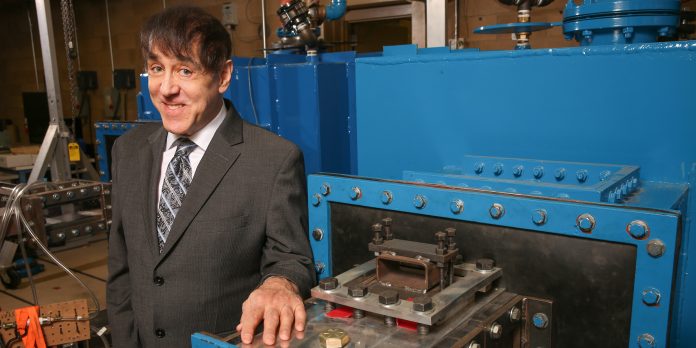HUNTSVILLE – The eminent scholar in propulsion at the University of Alabama in Huntsville has been awarded the 2024 American Society of Mechanical Engineers Henry R. Worthington Medal for developing innovative micro, millimeter and macro-scale pumping devices.
Dr. Phillip Ligrani’s innovations are beneficial to applications, such as transporting biological samples without significant alteration or destruction of cells, and supplying coolant to maintain the temperatures of components subject to thermal loading, like lasers. The award will be presented at the ASME Fluids Engineering Division summer meeting on July 15-17 in Anaheim, Calif. Ligrani will also present a plenary lecture detailing his findings.
The award, one of the most prestigious given by ASME, recognizes “innovative and unique pumping concepts and devices with micro-, millimeter- and macro-scale flow passage arrangements in consideration of the displacement of fluids subject to diverse physical phenomena.”
Ligrani’s work at UAH includes the development of a variety of rotary shaft pumps, viscous disk pumps, an osmotic dispense pump and a viscous disk air flow displacement device. These advances have been featured in more than 15 journal papers and have garnered two published patents, working with a variety of fluids, including water, 5W-30 motor oil, sucrose solutions and polymer solutions, as well as gases, such as helium and air.
“In regard to transport of delicate biological matter, such as cells, the key is displacement of the matter without imposition of extra forces or shear gradient variations that may damage, tear or distort the cells,” Ligrani said. “Several versions of our viscous disk pumps are ideally suited to this purpose, wherein flow motion and cell motion are induced with very small amounts of flow shear by a rotating disk.
“By controlling the motion of such a disk, specific and controlled amounts of fluid can also be displaced, which is ideal for ‘lab-on-a-chip’ arrangements.”
The devices also support the science of polyacrylamide polymers, which are used as thickeners and flocculants to make particles adhere to form larger particles.
“Key items which describe pump performance are pressure rise produced, flow rate of the fluid and pump power requirements,” Ligrani said. “A variety of physical phenomena have been investigated in regard to their effects on these performance criteria, including elastic instabilities and elastic turbulence. When elastic instabilities are present, collections of long-chain polymers interact and gyrate, which stirs up and mixes the flow at microscopic scales. The result is increased flow turbulence within very small environments, where normal turbulent motions cannot exist.
“As a result, when present, elastic instabilities result in larger pump pressure rises, and increased pump power consumption.”
Several of these pumping devices are particularly beneficial for providing coolant to electronic cooling components, as well as for high-power laser diode arrays within solid-state high energy laser assemblies, especially where flow passages are micro-scale and millimeter-scale in size.
“The key for both applications is maintaining components at acceptable temperature levels,” Ligrani said. “Such thermal management is essential for LDA and SSHEL devices to operate properly, because operating lasers generally create significant amounts of heat. In addition, raising the operating temperatures of semiconductor chips and solid-state crystals generally results in shorter operating lifetimes of these components.
“Therefore, it is paramount to equip high-power lasers and electronic components with effective and efficient thermal management, wherein coolant is provided by efficient small-scale pumping devices.”
Don’t miss out! Subscribe to our email newsletter to have all our smart stories delivered to your inbox.



